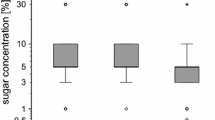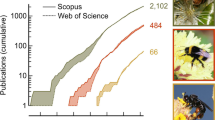Abstract
The left and right antennae of stingless bees have different roles in learning and recall of olfactory memory. Antennal asymmetry in social behavior is reported here. Approaches and physical contacts were scored in dyads of stingless bees (Tetragonula carbonaria): dyads in which both bees had only their right antennae (left antennae removed) made significantly more physical contacts with each other than dyads in which both bees had only their left antennae. In dyads of one left and one right, it was found, unexpectedly, that the bee with a left antenna approached the bee with the right antenna more often that the other way around, and the bee with the left antenna often attacked (by biting) its hive mate. Hence, the low number of contacts in dyads of bees using their left antennae appears to be due to mutual avoidance. Whereas use of the right antenna stimulates positive contact, the left stimulates avoidance or attack. Via such left-right asymmetries, intact bees may compute behavior directed towards friend and foe. Such antennal asymmetry may have evolved concomitantly with eusocial behavior. We found no evidence that it was associated with significant differences in the number of olfactory or non-olfactory sensilla on the left versus right antenna.


Similar content being viewed by others
References
Anfora A, Rigosi E, Frasnelli E, Ruga V, Trona F, Vallortigara G (2011) Lateralization in the invertebrate brain: left-right asymmetry of olfaction in bumble bee, Bombus terrestris. Plos One 6(4):e18903
Camargo JMF, Pedro SR (1992) Systematics, phylogeny and biogeography of the Meliponinae (Hymenoptera, Apidae): a mini-review. Apidologie 23:509–522
Cardinal S, Danforth BN (2011) The antiquity and evolutionary history of social behavior in bees. PLoS One 6(6):e21086. doi:10.1371/journal.pone.0021086
Cunningham JP, Hereward JP, Heard TA, De Barro PJ, West SA (2014) Bees at war: interspecific battles and nest usurpation in stingless bees. Am Nat 184:777–786
Dollin, A.E. (2008). The mysterious fighting swarms. Aussie Bee online, article 13. www.aussiebee.com.au/abol-013.html
Frasnelli E, Anfora G, Trona F, Tessarolo F, Vallortigara G (2010) Morpho-functional asymmetry of the olfactory receptors of the honeybee (Apis mellifera). Behav Brain Res 209(2):221–225
Frasnelli E, Vallortigara G, Rogers LJ (2011) Origins of brain asymmetry: lateralization of odour memory recall in primitive Australian stingless bees. Behav Brain Res 224:121–127
Frasnelli E, Vallortigara G, Rogers LJ (2012) Left-right asymmetries of behaviour and nervous system in invertebrates. Neurosci Biobehav Rev 36:1273–1291
Ghirlanda S, Vallortigara G (2004) The evolution of brain lateralization: a game theoretical analysis of population structure. Proc R Soc Lond B 271:853–857
Ghirlanda S, Frasnelli E, Vallortigara G (2009) Intraspecific competition and coordination in the evolution of lateralization. Philos Trans R Soc Lond B 364:861–866
Gloag R, Heard TA, Beekman M, Oldroyd BP (2008) Nest defense in a stingless bee: what causes fighting swarms in Trigona carbonaria (hymenoptera, Meliponini)? Insect Soc 55:387–391
Heard TA (1996) The stingless bees. Nat Aust 25:51–55
Johnson LK, Hubbell SP (1974) Aggression and competition among stingless bees: field studies. Ecology 55:120–127
Johnson LK, Haynes LW, Carlson MA, Fortnum HA, Gorgas DL (1985) Alarm substances of the stingless bee, Trigona silvestriana. J Chem Ecol 11:409–416
Meng ZJ, Yan SC, Yang CP, Ruan CC (2012) Asymmetrical distribution of antennal sensilla in the female Anastatus japonicus Ashmead (Hymenoptera: Eupelmidae). Microsc Res Tech 75:1066–1075
Rogers LJ, Vallortigara G (2008) From antenna to antenna: lateral shift of olfactory memory recall by honeybees. PLoS One 3(6):e2340. doi:10.1371/journal.pone.0002340
Rogers LJ, Workman L (1989) Light exposure during incubation affects competitive behaviour in domestic chicks. Appl Anim Behav Sci 23:187–198
Rogers LJ, Vallortigara G, Andrew RJ (2013a) Divided brains: the biology and behaviour of brain asymmetries. Cambridge University Press, Cambridge
Rogers LJ, Rigosi E, Frasnelli E, Vallortigara G (2013b) A right antenna for social behaviour in honeybees. Sci Rep 3:2045. doi:10.1038/srep0245
Roubik DW (1980) Foraging behavior of competing Africanized honeybees and stingless bees. Ecology 61:836–845
Shackelton K, Toufailia HA, Balfour NJ, Nascimento FS, Alves DA, Ratnieks FLW (2015) Appetite for self-destruction: suicidal biting as a nest defense strategy in Trigona stingless bees. Behav Ecol Sociobiol 69:273–281
Vallortigara G, Rogers LJ (2005) Survival with an asymmetrical brain: advantages and disadvantages of cerebral lateralization. Behav Brain Sci 28:575–633
Acknowledgments
LR thanks Dr. Adam Koboroff for some initial statistical analyses. The imaging research was supported by Professor Giorgio Vallortigara, Director, Centre for Mind/Brain Sciences, University of Trento, 38068 Rovereto, TN, Italy. EF is grateful to Federico Piccoli, Department of Medicine Laboratory, APSS, Trento, for technical support with using the scanning electron microscope.
Author information
Authors and Affiliations
Corresponding author
Rights and permissions
About this article
Cite this article
Rogers, L.J., Frasnelli, E. Antennal Asymmetry in Social Behavior of the Australian Stingless Bee, Tetragonula carbonaria . J Insect Behav 29, 491–499 (2016). https://doi.org/10.1007/s10905-016-9575-z
Revised:
Accepted:
Published:
Issue Date:
DOI: https://doi.org/10.1007/s10905-016-9575-z




